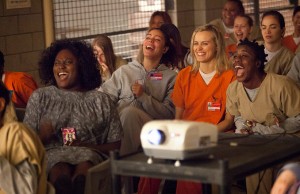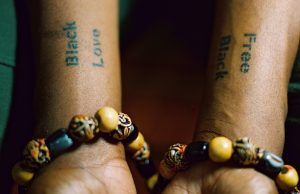Trans Is the New Black?: On CeCe McDonald, Mister Cee, Orange Is The New Black, and Trans Women of Color
By Jasmine Salters
Last week, the appearance of Orange Is the New Black actress Laverne Cox and former RuPaul’s Drag Race contestant and trans model Carmen Carrerra on Katie Couric’s ABC daytime show Katie sparked important dialogue about transgender individuals. When Couric asked the women invasive questions about transitioning and surgery, Cox powerfully deconstructed the ways in which fixation on the bodies of transgender people distracts from their material realities. “By focusing on bodies,” Cox said, “we don’t focus on the lived realities of that oppression and that discrimination.” Cox then discussed the 2013 murder of Islan Nettles, a 21-year-old trans woman of color beaten to death in New York City in order to call attention to the staggering rate of violence against trans people throughout the United States.
Cox is also producing Free CeCe!, a documentary about trans woman CeCe McDonald, who was released early from prison this Monday after serving 19 months of a 41-month sentence for second-degree manslaughter. In June 2011, McDonald and four friends were headed to a grocery store when they were confronted by a group of men hurling racist and transphobic remarks along with drinks and broken glass. A brawl quickly ensued, leaving McDonald injured and bleeding and Dean Schmitz dead from a stab wound to the chest. In an interview with Persephone Magazine, Cox explained:
Trans women, particularly trans women of color, experience disproportionate amounts of violence and not enough is being done to eradicate that violence. CeCe’s story in so many ways encapsulates the intersectional issues that lead to far too many of us experiencing violence. I wanted to do a piece that explores the nature of how race, class and gender affect violence towards trans women and also give CeCe a space to tell her story in her words in the context of a piece that truly values the lives of trans women of color.
Another example of the devaluing of trans women of color occurred during the 2013 “scandal” involving Calvin Lebrun (better known as Mister Cee), one of hip-hop’s pioneering DJs. On September 12, 2013, Lebrun confessed to “getting sexual fellatio in a car with a transsexual” on New York City’s Hot 97 “The Morning Show.” The public confession came one day after an audio recording of Mister Cee’s encounter with an unnamed transgender sex worker was released. His intended resignation was declined when Program Director Ebro Darden assured him during the interview, “There’s nothing wrong with being who you are! You’re free, Cee!” Mister Cee retuned to Hot 97 the next day.
I appreciated Mister Cee’s honesty, and Darden’s reassurance for Mister Cee to live his truth seemed to signal a turn that would lead hip-hop toward more acceptance of and appreciation for transgender individuals. I was left wondering, however, about the women implicated and shamed in these conversations. What about the truth and beauty of the lives of transgender people who experience disproportional discrimination in education, housing, and employment, poverty, assault, attempted suicide? Trans activist Janet Mock writes,
Many men are attracted to women, and trans women are amongst these women. The shame that society attaches to these men, specifically attacking their sexuality and shaming their attraction, directly affects trans women. It affects the way we look at ourselves. It amplifies our body-image issues, our self-esteem, our sense of possibility, of daring for greatness, of aiming for something or somewhere greater.
On HuffPost Live, Cox also commented on the relationship between trans individuals and hip-hop: “There’s consistently an erasure of trans identity when we have these discussions. The reason I’m here is because whenever we have these discussions, trans women’s voices are not included… The extent to which men who date us or are attracted to us are stigmatized is so intense.”
This stigma does not only exist in hip-hop, however, and I find it to be perpetuated on Orange Is the New Black (OITNB), the acclaimed Netflix prison drama based on the life of Piper Kerman. As aforementioned, OINTB stars Cox as trans inmate Sophia Burset. In an interview on NPR’s Fresh Air, Jenji Kohan, the show’s creator, described Kerman as “my Trojan Horse,” explaining, “You’re not going to go into a network and sell a show on really fascinating tales of black women, and Latina women, and old women and criminals.” But, if you take Kerman, the “girl next door, the cool blonde,” you have a “very easy access point […] relatable for a lot of audiences and a lot of networks looking for a certain demographic. [She’s] useful.” Kohan’s remarks raise important questions about why the stories of black women and other marginalized groups must be mediated through whiteness and if, in fact, such strategies function to advance American race and gender relations: Is Piper’s white privilege enough to raise awareness about the impact of mass incarceration on communities of color, particularly women and transgender individuals? Would the same people binge-watch the series once Piper leaves Litchfield (as she eventually does in real life)? Is the public confession and rehiring of Mister Cee enough to make hip-hop more trans-inclusive? Do any of these events work to eradicate the public and private shaming of non-heteronormative sexualities and desires?
In “White Is the New White,” Aura Bogado problematizes the long-lasting deployment of the white authentication of black experiences. Similarly, Mohadesa Najumi notes that while OITNB “provides a relative voice for trans and queer issues,” the “Black and Latina experiences are diluted through myopic stereotypes and racist tropes.” Yasmir Nair also calls attention to the “show’s inability to examine the structural factors that determine who ends up behind bars” and its disregard for women of color who have and continue to lead prison movements and contest prison conditions.
Admittedly, I find myself conflicted, both cringing at the constructions of women of color and the prison industrial complex on OINTB but falling head over heels for Sophia Burset and other characters on the show. For once, I am able to hear “lifelike” conversations between women reminiscent of conversations we often have behind closed doors. I enjoy watching these women rocking afros, laughing and loving, cornrowing one another’s hair while they sit in between each other’s legs, doing the cabbage patch, and laughing, because these interactions are often excluded from media and popular culture.
Nevertheless, because these interactions are mediated through Piper’s middle-class, highly-educated whiteness, the women of color on OINTB are often dehumanized, caricatured, and hypersexualized, and their experiences become sensationalized fodder for comic relief. In one scene, as Nair has noted, Chapman stands with some inmates of color in the warden’s office, where she is the only one who raises serious issues concerning the conditions of their confinement, such as the discontinuation of GED classes. The other women, in contrast, are silenced by the “danger” of not getting doughnuts, coffee, and Sriracha. In addition, as Salamishah Tillet points out, “The real violence experienced by women in prison” is often cushioned “as romance.” Most notably, the “romance” between hypersexualized Latina inmate Daya Diaz and white corrections officer John Bennett masks the realities of the often violent and coercive sexual relationships between inmates and staff. (The National Prison Rape Elimination Commission reported that staff members rather than other prisoners commit over 60 percent of alleged acts of sexual abuse.) Thus, there seems to be a glossing over, a shallow acknowledgement at best, of the racialized society that spawned the prison industrial complex, the overarching effects of the War on Drugs, the fact that black and Hispanic women constitute the fastest growing prison population, and the heightened and disproportional individual and state-level gender policing and violence experienced by transgender people both inside and outside of prison. Trans people of color, in particular, are at a disproportionately high risk of being victims of what the National Coalition of Anti-Violence Programs terms hate violence. For example, trans women have a 1:12 chance of being murdered, while that number increases to 1:8 for trans women of color.
Contemporary television and radio shows have the potential to call attention to these issues, but they still function to maintain and protect white privilege and individual, structural, and institutional violence against trans people and people of color through an amalgamation of inaccurate, stereotypical, and whitewashed portrayals (and erasures) of marginalized bodies. Like Laverne Cox recently noted, we must elevate the actual voices of marginalized people so that we may speak the truths of our lived realities in ways that do not sensationalize and objectify. “[These] human voices and stories can be a part of the disruption needed to end the disproportionate injustices that threaten so many trans people’s lives, particularly the lives of trans women of color. It is a state of emergency for far too many trans people across this country.”
Until these voices are free to be heard and until these bodies are free from discrimination and violence, orange is not the new black, nor is trans. Black is still black. White is still white. Mister Cee is not truly free if CeCe McDonald is not.
_________________________________________________________
 j. n. salters is a black feminist writer and doctoral candidate at the Annenberg School for Communication at the University of Pennsylvania. She interested in the intersections of race, gender, class, and sexuality in rights to privacy, black cultural production, identity politics, sex work, law and criminal justice, and visual culture. Follow her on twitter @blkgirlwithapen.
j. n. salters is a black feminist writer and doctoral candidate at the Annenberg School for Communication at the University of Pennsylvania. She interested in the intersections of race, gender, class, and sexuality in rights to privacy, black cultural production, identity politics, sex work, law and criminal justice, and visual culture. Follow her on twitter @blkgirlwithapen.








2 Comments